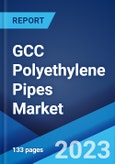Polyethylene (PE) is a light, versatile synthetic resin which is made from the polymerization of ethylene. Pipes made from polyethylene are used in various industries such as water supply, irrigation, sewage and drainage, gas supply, etc. PE pipes are durable, flexible, resistant to biological growth and do not corrode.
PE pipes offer numerous benefits that plays a major role in driving their demand in the GCC region. This includes low maintenance costs, easy installation process, corrosion and fatigue resistant properties and longer service life. The rapid increase in the demand for cheaper alternatives to steel pipes for the purpose of distributing oil and natural gas is one of the key factors propelling the demand of the GCC polyethylene pipes. Moreover, the major demand for PE pipes in the GCC region comes from the construction and infrastructure sector that includes water and gas distribution in residential and commercial units. Driven by strong economic growth and rising population, the construction industry in the GCC region has witnessed healthy growth rates in recent years. The Government in the region has been promoting the usage of PE pipes as they help in reducing the greenhouse gas emissions. Additionally, these pipes are used in desalinating seawater, treating wastewater and supplying water for irrigation purposes. Moreover, PE pipes are superior to steel and cement pipes and are being widely preferred in agricultural applications.
Key Market Segmentation:
The publisher provides an analysis of the key trends in each segment of the GCC polyethylene pipes (PE) market report, along with forecasts at the regional and country levels from 2023-2028. The report has categorized the market based on type and application.Breakup by Type:
- HDPE
- LDPE
- MDPE
- LLDPE
Breakup by Application:
- Water Supply
- Irrigation
- Sewerage and Drainage
- Gas Supply
- Others
Breakup by Country:
- Saudi Arabia
- UAE
- Qatar
- Kuwait
- Oman
- Bahrain
Competitive Landscape
The market consists of numerous small and large players who compete in terms of prices and quality. The report provides an insight into the competitive landscape along with the profiles of the key players operating in this market.Key Questions Answered in This Report:
- How has the GCC PE pipes market performed so far and how will it perform in the coming years?
- What has been the impact of COVID-19 on the GCC PE pipes industry?
- What is the breakup of the GCC PE pipes market based on the type?
- What is the breakup of the GCC PE pipes market based on the application?
- What is the country-wise breakup of the GCC PE pipes market?
- What are the price trends of the PE pipes in the GCC region?
- What are the various stages in the value chain of the GCC PE pipes industry?
- What are the key driving factors and challenges in the GCC PE pipes industry?
- What is the structure of the GCC PE pipes industry and who are the key players?
- What is the degree of competition in the GCC PE pipes industry?
- What are the profit margins in the GCC PE pipes industry?
- What are the key requirements for setting up a PE pipes manufacturing plant?
- How are PE pipes manufactured?
- What are the various unit operations involved in a PE pipe manufacturing plant?
- What is the total size of land required for setting up a PE pipe manufacturing plant?
- What are the machinery requirements for setting up a PE pipe manufacturing plant?
- What are the raw material requirements for setting up a PE pipe manufacturing plant?
- What are the packaging requirements for PE pipes?
- What are the transportation requirements for PE pipes?
- What are the utility requirements for setting up a PE pipe manufacturing plant?
- What are the manpower requirements for setting up a PE pipe manufacturing plant?
- What are the infrastructure costs for setting up a PE pipe manufacturing plant?
- What are the capital costs for setting up a PE pipe manufacturing plant?
- What are the operating costs for setting up a PE pipe manufacturing plant?
- What will be the income and expenditures for a PE pipe manufacturing plant?
- What is the time required to break-even?
Table of Contents
Methodology

LOADING...
Table Information
| Report Attribute | Details |
|---|---|
| No. of Pages | 133 |
| Published | September 2023 |
| Forecast Period | 2022 - 2028 |
| Estimated Market Value in 2022 | 691400 Tons |
| Forecasted Market Value by 2028 | 942570 Tons |
| Compound Annual Growth Rate | 5.3% |
| Regions Covered | Middle East |









